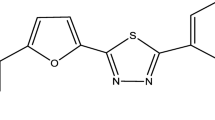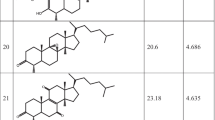Abstract
The aim of the present study is to show how molecular topology can be a powerful in silico tool for the prediction of the fungicidal activity of several diphenylamine derivatives against three fungal species (cucumber downy mildew, rice blast and cucumber gray mold). A multi-target QSAR model was developed, and two strategies were followed. First is the construction of a virtual library of molecules using DesMol2 program and a subsequent selection of potential active ones. Second is the selection of molecules from the literature on the basis of molecular scaffolds. More than 700 diphenylamine derivatives designed and other 60 fluazinam’s derivatives with structural similarity higher than 80% were studied. Almost twenty percent of the molecules analyzed show potential activity against the three fungal species.




Similar content being viewed by others
References
Kumar A, Tiwari A, Sharma A (2018) Changing paradigm from one target one ligand towards multi target directed ligand design for key drug targets of Alzheimer disease: an important role of in silico methods in multi target directed ligands design. Curr Neuropharmacol. https://doi.org/10.2174/1570159x16666180315141643
Abeijon P, Garcia-Mera X, Caamano O, Yanez M, Lopez-Castro E, Romero-Duran FJ, Gonzalez-Diaz H (2017) Multi-target mining of alzheimer disease proteome with Hansch’s QSBR-perturbation theory and experimental-theoretic study of new thiophene isosters of rasagiline. Curr Drug Targets 18(5):511–521. https://doi.org/10.2174/1389450116666151102095243
Zanni R, Galvez-Llompart M, Galvez J, Garcia-Domenech R (2014) QSAR multi-target in drug discovery: a review. Curr Comput Aided Drug Des 10(2):129–136
Garcia-Domenech R, Zanni R, Galvez-Llompart M, Galvez J (2015) Predicting antiprotozoal activity of benzyl phenyl ether diamine derivatives through QSAR multi-target and molecular topology. Mol Divers 19(2):357–366
Tenorio-Borroto E, Garcia-Mera X, Peñuelas-Rivas CG, Vasquez-Chagoyan JC, Prado-Prado FJ, Castañedo N, Gonzalez-Díaz H (2013) Entropy model for multiplex drug-target interaction endpoints of drug immunotoxicity. Curr Top Med Chem 13(14):1636–1649
Zanni R, Galvez-Llompart M, García-Domenech R, Galvez J (2015) Latest advances in molecular topology applications for drug discovery. Expert Opin Drug Discov 10(9):945–957. https://doi.org/10.1517/17460441.2015.1062751
Garcia-Domenech R, Galvez J, de Julian-Ortiz JV, Pogliani L (2008) Some new trends in chemical graph theory. Chem Rev 108(3):1127–1169. https://doi.org/10.1021/cr0780006
Zanni R, Galvez-Llompart M, Machuca J, Garcia-Domenech R, Recacha E, Pascual A, Rodriguez-Martinez JM, Galvez J (2017) Molecular topology: a new strategy for antimicrobial resistance control. Eur J Med Chem 8(137):233–246. https://doi.org/10.1016/j.ejmech.2017.05.055
Zanni R, Galvez-Llompart M, Morell C, Rodríguez-Henche N, Díaz-Laviada I, Recio-Iglesias MC, Garcia-Domenech R, Galvez J (2015) Novel cancer chemotherapy hits by molecular topology: dual Akt and Beta-catenin inhibitors. PLoS ONE 10(4):e0124244. https://doi.org/10.1371/journal.pone.0124244
Galvez-Llompart M, Recio MC, Garcia-Domenech R, Galvez J (2017) Molecular topology: a strategy to identify novel compounds against ulcerative colitis. Mol Divers 21(1):219–234. https://doi.org/10.1007/s11030-016-9706-7
García-Domenech R, Aguilera J, El Moncef A, Pocovi S, Galvez J (2010) Application of molecular topology to the prediction of mosquito repellents of a group of terpenoid compounds. Mol Divers 14:321–329
Bashir Y, Aslam A, Kamran M, Qureshi MI, Jahangir A, Rafiq M, Bibi N, Muhammad N (2017) On forgotten topological indices of some dendrimers structure. Molecules 22(6):867. https://doi.org/10.3390/molecules22060867
Chen CP, Chen CC, Huang CW, Chang YC (2018) Evaluating molecular properties involved in transport of small molecules in stratum corneum: a quantitative structure-activity relationship for skin permeability. Molecules 23(4):911. https://doi.org/10.3390/molecules23040911
Szczechura W, Staniaszek M, Klosinska U, Kozik EU (2015) Molecular analysis of new sources of resistance to Pseudoperonospora cubensis (Berk. et Curt.) Rostovzev in cucumber. Russ J Genet 51(10):974–979
Gladieux P, Ravel S, Rieux A, Cros-Arteil S, Adreit H, Milazzo J, Thierry M, Fournier E, Terauchi R, Tharreau D (2018) Coexistence of multiple endemic and pandemic lineages of the rice blast pathogen. MBio 9(2):e01806–e01817. https://doi.org/10.1128/mBio.01806-17
Deng JJ, Huang WQ, Li ZW, Lu DL, Zhang Y, Luo XC (2018) Biocontrol activity of recombinant aspartic protease from Trichoderma harzianum against pathogenic fungi. Enzyme Microb Technol 112:35–42. https://doi.org/10.1016/j.enzmictec.2018.02.002
Fernández-Ortuño D, Tores JA, de Vicente A, Pérez-García A (2008) Mechanisms of resistance to QoI fungicides in phytopathogenic fungi. Int Microbiol 11(1):1–9
Martinez-Cruz J, Romero D, de Vicente A, Perez-García A (2017) Transformation of the cucurbit powdery mildew pathogen Podosphaera xanthii by Agrobacterium tumefaciens. N Phytol 213(4):1961–1973. https://doi.org/10.1111/nph.14297
Li H, Guan A, Huang G, Liu CL, Li Z, Xie Y, Lan J (2016) Design, synthesis and structure-activity relationship of novel diphenylamine derivatives. Bioorg Med Chem 24(3):453–461. https://doi.org/10.1016/j.bmc.2015.09.032
ChemDraw Ultra package (version 10.0) (2009) CambridgeSoft
Kier LB, Hall LH (1986) Molecular connectivity in structure-activity analysis, 1st edn. Research Studies Press, Letchworth
Galvez J, Garcia-Domenech R, Salabert MT, Soler R (1994) Charge indexes. New topological descriptors. J Chem Inf Comput Sci 34:520–525
Galvez J, Garcia-Domenech R, de Julian-Ortiz JV, Soler R (1995) Topological approach to drug design. J Chem Inf Comput Sci 35:272
Garcia-Pereira I (2018) Desmol2 software. Department of Physical Chemistry. Faculty of Pharmacy. University of Valencia. http://desmol2.uv.es
Klecka WR (1980) Discriminant analysis. Sage University paper series on quantitative applications in the social sciences, 1st edn. Sage Publications, Beverly Hills
StatSoft I. Statistica (data analysis software system) (2009) Version 9. Tulsa, USA
De Maesschalck R, Jouan-Rimbaud D, Massart D (2000) The Mahalanobis distance. Chemom Intell Lab Syst 50(1):1–18
Roderick LJA, Rubin DB (2014) Statistical analysis with missing data, vol 333. Wiley, Hoboken
Speck-Planche A, Kleandrova VV, Luan F, Cordeiro MN (2012) Fragment-based approach for the in silico discovery of multi-target insecticides. Mol BioSyst 8(8):2188–2196
ChemIDplus A TOXNET DATABASE (2018) https://chem.nlm.nih.gov/chemidplus/
Acknowledgements
Authors acknowledge the MINECO (Spanish Ministry of Economy, Industry and Competitivity) Project: “Desarrollo de nuevas herramientas para el control de oidios” (AGL2016-76216-C2-2-R). I.GP acknowledges the MECD (Spanish Ministry of Education, Culture and Sport) Program: “University teacher formation,” to carry out this study.
Author information
Authors and Affiliations
Corresponding author
Electronic supplementary material
Below is the link to the electronic supplementary material.
Rights and permissions
About this article
Cite this article
Zanni, R., Galvez-Llompart, M., Garcia-Pereira, I. et al. Molecular topology and QSAR multi-target analysis to boost the in silico research for fungicides in agricultural chemistry. Mol Divers 23, 371–379 (2019). https://doi.org/10.1007/s11030-018-9879-3
Received:
Accepted:
Published:
Issue Date:
DOI: https://doi.org/10.1007/s11030-018-9879-3




